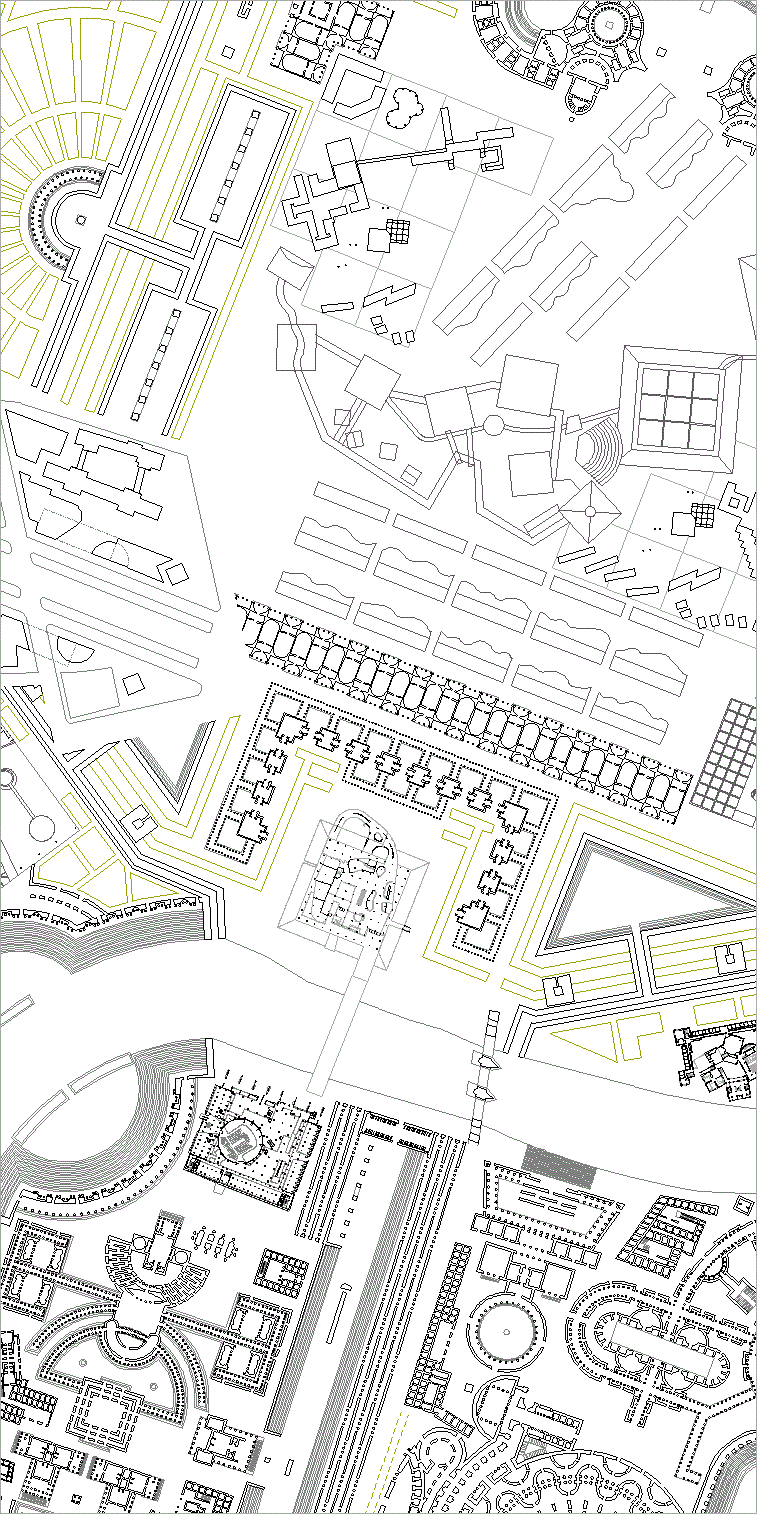Inside the Density of G. B. Piranesi's Ichnographia Campus Martius
reenactment architectures 10.1
from: Rick McBride
1999.11.08 23:39
reenacment
Stephen:
That is a new twist: "Reenactment" as a Sixth Theory of Design prescription. It recalls Serlio's famous pair of street scenes--what were they? Tragedy and Comedy, or something like it? That was one of Colin Rowe's favorite theses in the Seventies, but I was too busy trying to keep a small practice going in Dallas to pay enough attention. Still, I should think Serlio's exciting notion carried the same implications as do all the talk of street theaters, theater of the street, etc., today. And I think you may be correct. The first problem I see is that Reenactment is still a fairly weak hypothesis.
So, thinking of it that way (hypothetically), I should imagine: The engine for it would almost certainly be set in Pragmatic philosophy--which is to say, Contextualism. A prime source would recall the Pragmatic demand for the history of a site to be enacted, or reenacted, with whatever develops newly upon it. For designers within the Contextual mode this is a prime imperative. I think of it as the history of the site welling up into the design of this site. You speak of it as reenactment [--Rick incorrectly interpolates here]. The important difference is that for me this has always been one more detail of the design problem: Its history, welling up. But for you it is the chance for a much more positive enactment of the old mixed with the new--a new Categorial, so to speak. Indeed, given the viewpoint of our times, your theme could very well become one of the strong expressions of Contextual Design. The great problem has always been that these exciting ideas never get developed. They are tossed into the spotlight, and the next question becomes, So what else is new?
No other major philosophy offers this active historical paradigm. But too, this sort of design imperative is quite different from the Mechanism (i.e.: sub category being some neo Positivism, perhaps post Structuralism) which supports Piranesi's atomism of Rome. So, I should think that your reenactment thesis puts you on a different pony than do your deductivisms concerning the deconstructions of Ichnographia Campus Martius deconstructing Rome--or, as you put so well, "lots of redux redux."
In other words, these seem to be two horses, and you appear to be riding them both. Importantly, on the one hand, your nice use of historical anecdotes (for instance, Ludwig II's marriage with Disney World) is just the ticket for bringing off a full scale assault upon old Contextualism. It would mean shaking it by the throat until it coughed up a most important (full scaled) Theory of reEnactment. By it, Contextualism might be taken out of the ashes and made to gallop a few more times around the Town Square. But on the other hand, the urge toward the excellent historiography of Piranesi is quite another matter.
I wait to see how you square the one with the other.
Rick McBride M.Arch Cornell 1965
Urban Design studio of Colin Rowe and Werner Seligmann
presently, Assoc Prof of Architecture at the University of Texas at Arlington
ps:
I began architecture school at Univ of Tex at Austin, 1954 under Bernhard Hoesli, Colin Rowe, Bob Slutzky, John Hejduk, Werner Seligmann, Lee Hodgden, and John Shaw; they otherwise are known as The Texas Ranges (see Alex Caragonne's book of that same name, published in 1995; MIT Press; Alex was kind enough to mention me a few times, so maybe that was where you saw my name.)
Otherwise, I wrote a most forgettable article on Louis I Kahn, calculated to show how unmodern he was, yet how in the early years he developed several instances of Phenomenal Transparency. It came out in A+U 1977, July, cont. to Aug. The most important thing I can remember being said about it was from Jerry Wells: "Who could read it? Isn't it in Japanese?" Other publications of mine (there are several) are lost little treasures which even I no longer care to remember.
pss:
Small dictionaries lead one from "opificem" to "officina", when it may also be that "officium" is in line: "dutiful or respectfull action". The Oxford Latin Dictionary lists "probatio" as something approved after inspection. Thus, I think it means, The work respects the workman. Perhaps it means, The work stands for the workman.?? This last is actually the way I had thought of it until I had to look it up.
| |

| |
1999.12.28 13:09
"there's never been a design that proved something"
One of the last events of my trip to Brussels, Belgium was a Thanksgiving dinner on Saturday night, 27 November, hosted by Elia Zenghelis and Eleni Gigantes. About half of the guests were some of the participants of Inside Density. During dinner I sat next to Mark Wigley (Princeton University, author of The Architecture of Deconstruction, keynote speaker at Inside Density), and across from Mark sat Hilde Heynen (Katholic University Leuven, author of Architecture and Modernity: a critique, scientific committee member of Inside Density), and across from me sat Eleni Kostika (one of the two Elenis).
At one point I head Mark Wigley say to Hilde Heynen that "there's never been a design that proved something." My immediate reaction was that that didn't sound right, so I jumped in and said that Le Corbusier's design of the unexecuted Palais des Congres proves Le Corbusier's 'promenade architecturale' formula. [What I should have said is that the Palais des Congres, when compared with the Villa Savoye, proves that Le Corbusier followed a promenade architecturale formula.] Wigley quickly retorted that the Palais des Congres design only demonstrates the promenade architecturale, it doesn't prove it. I think at that point it was time to get dessert, so the conversation ended there.
So, my question to design-l is: is there a design (somewhere, anywhere) that proves something?
|